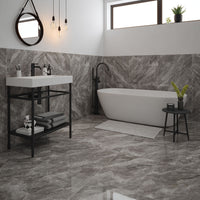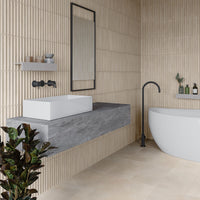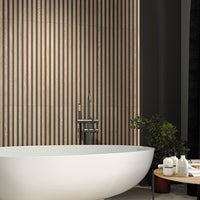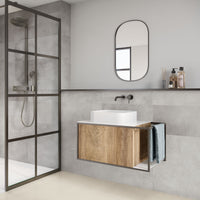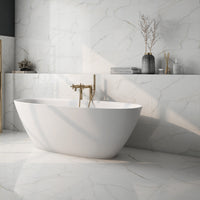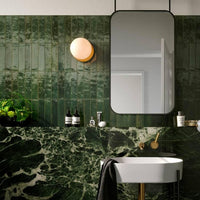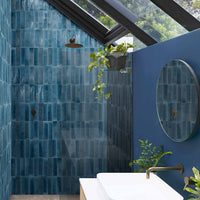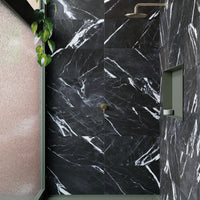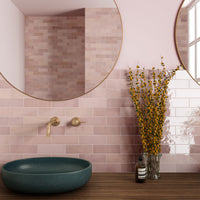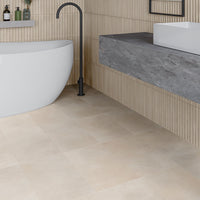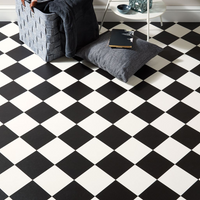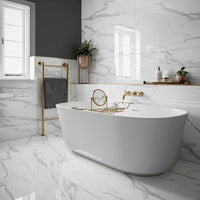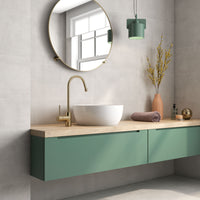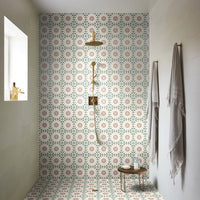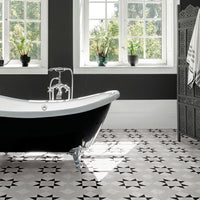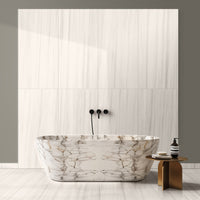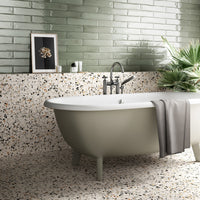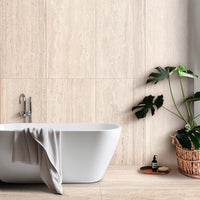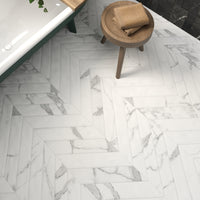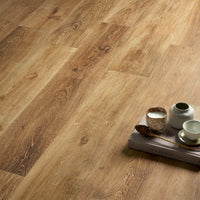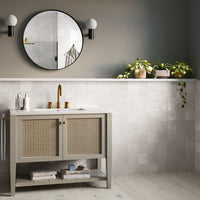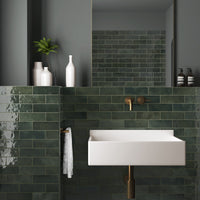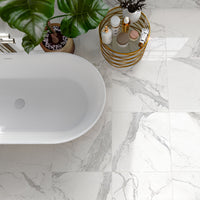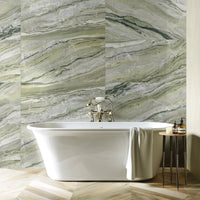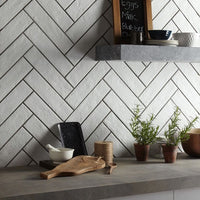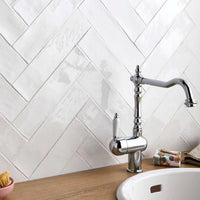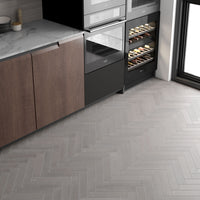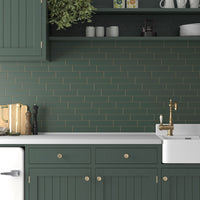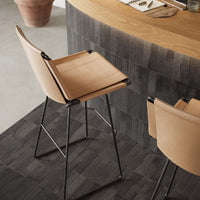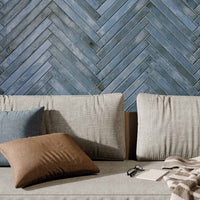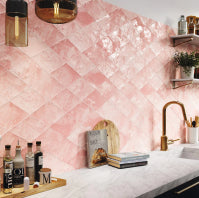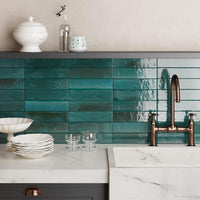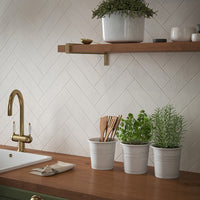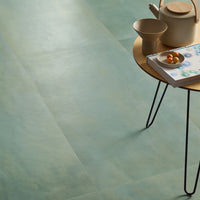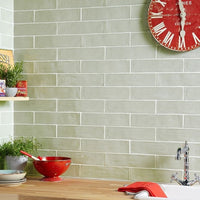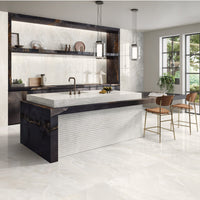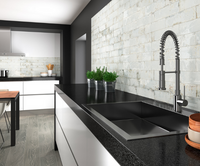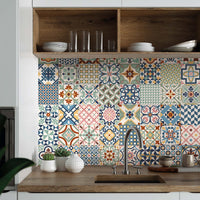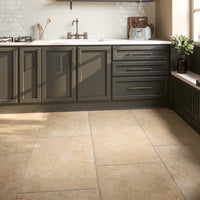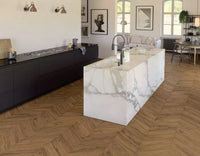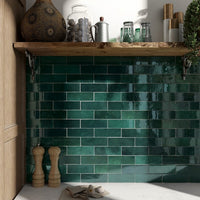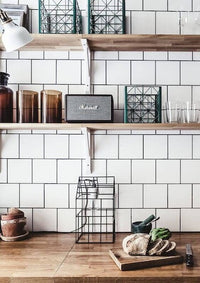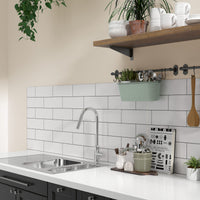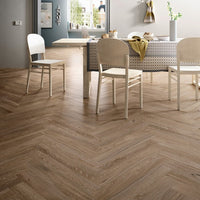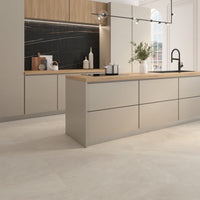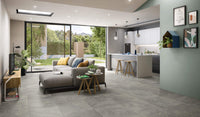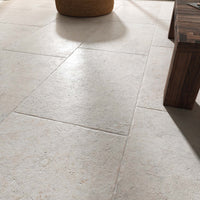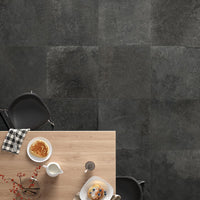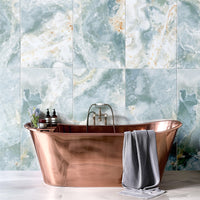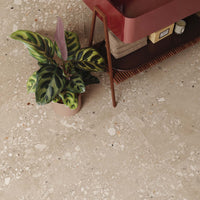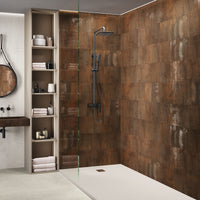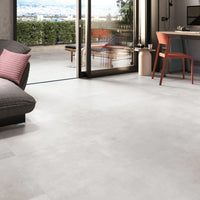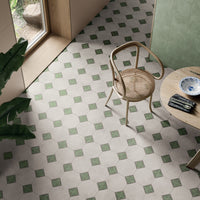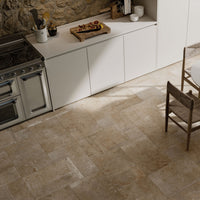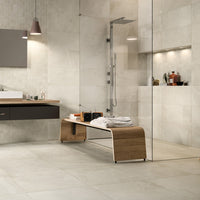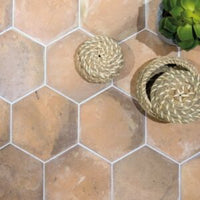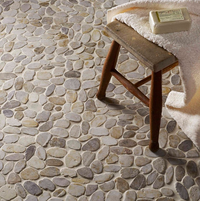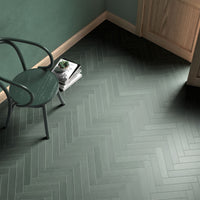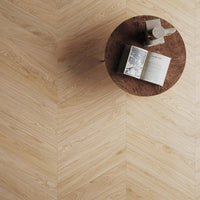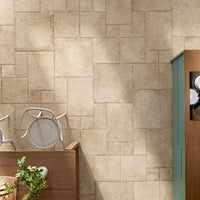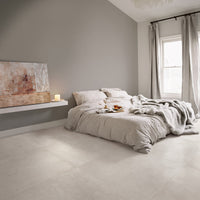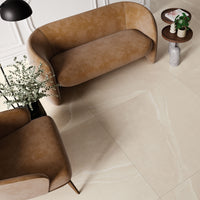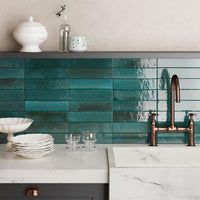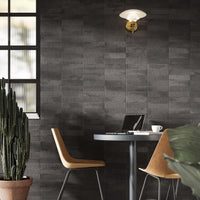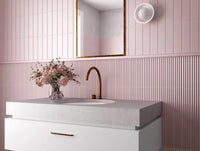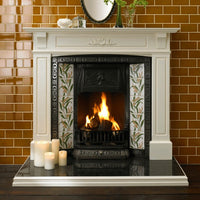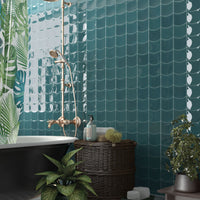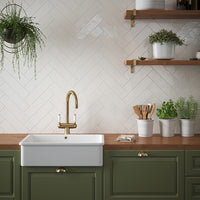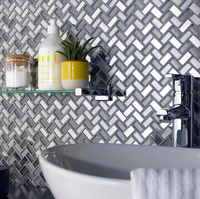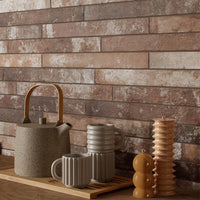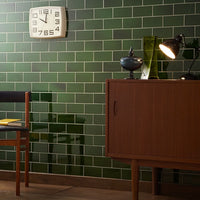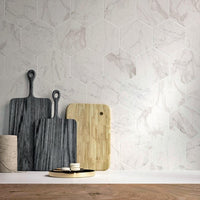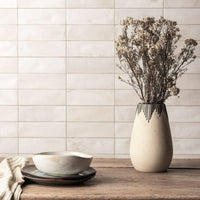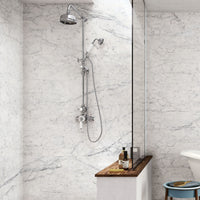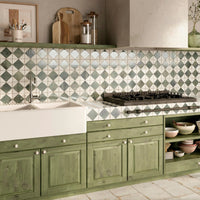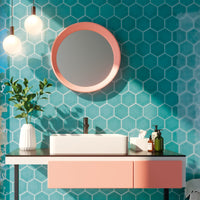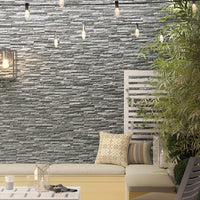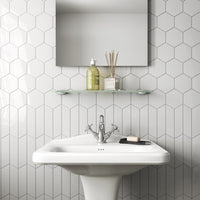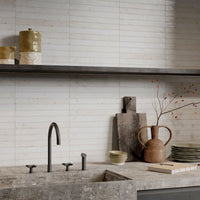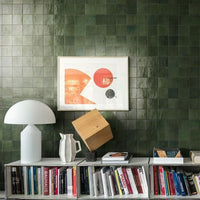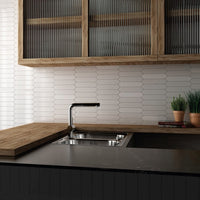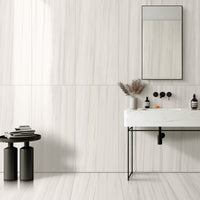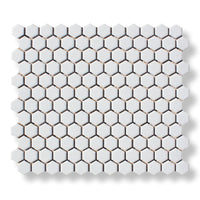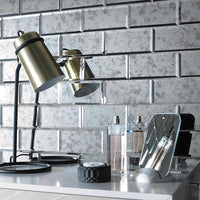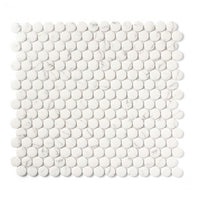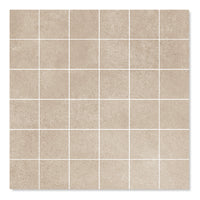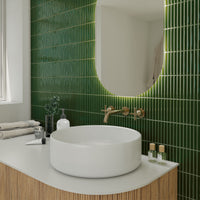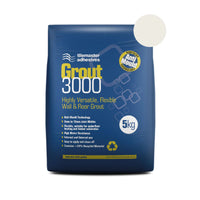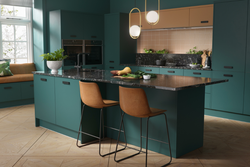It’s easy to see why wood effect tiles have become a hot interior trend in recent years. They bring the natural character of timber into your home, as well as being incredibly easy to live with.
But if you’re thinking of transforming your home with timber tiles, knowing where to start can be tricky. After all, there’s so many different sizes and styles available! This guide covers all you need to know, helping you make the right choice for you and your family home.
What are wood effect tiles?
As the name suggests, wood effect tiles are tiles that look like real wood. Designed to be used on floors, they will give your home the beauty of a natural timber floor with the practicality of tiles.
Most wood tiles are made from glazed porcelain, so they’re a lot harder and more durable than traditional ceramic tiles. They’re produced using cutting edge printing technology, which replicates the grains and knots of natural oak in high definition.
You’ve probably walked on many wooden tiles without realising - the latest designs are so realistic you can’t tell the difference!
The benefits of wood effect tiles
Whatever life throws at them, our wood effect tiles will cope. As they’re made from porcelain, they’re incredibly durable and ideal for busy family homes, so can be laid on almost any floor indoors.
They offer numerous advantages over other materials you might use for floors, such as real timber planks, laminate, engineered wood and vinyl floors. Let’s take a closer look at some of the benefits.
Incredibly lifelike
It’s becoming increasingly difficult to tell wood tiles apart from natural oak, with knots, grains and burls faithfully reproduced using HD technology. And it’s not just style too - the best wood tiles replicate the undulating feel of timber underfoot.
Waterproof
Unlike natural and engineered timber, water can’t penetrate the surface of wood tiles. This means they’re completely safe to use on bathroom floors - as an added bonus, they won’t rot or warp with changes in humidity.
Stain resistant
It’s not just water. Other liquids such as coffee and wine also find it difficult to stain porcelain tiles. And we should also mention that you won’t need to oil or seal porcelain tiles to maintain their look - not during or after installation. Or ever, in fact.
Scratch resistant
Far harder than even mighty oak, wood effect tiles will happily stand up to the stresses of busy family life. They won’t be dented by high heels and are very difficult to scratch - so your new floor will look great for a long time.
Easy to clean
Porcelain tiles are called low maintenance for a reason - as there’s nowhere for dust to hide, a quick brush-up will often do the trick. Whilst tile-specific cleaners are available, a mop with warm water should suffice for deeper cleans.
Won’t degrade
Our wood tiles are extremely stable and won’t rot or warp over time, even when immersed in water. They're also unaffected by sunlight, so won't fade if laid in garden rooms or conservatories, where there’s plenty of glass and natural light.
Long lasting and cost effective
As they are so hard-wearing, our wood tiles are a great investment and will look great for years to come. As they won't need replacing, they're a very cost-effective option compared to other flooring options.
Where can I use wood effect tiles?
Our porcelain wood effect tiles are the perfect fit for busy family home. And one of their main advantages is their versatility - they can be laid in almost any room, unlike alternatives such as laminates or traditional oak floors. These materials are easily scratched or dented and aren't always suitable for wet spaces.
Kitchens
Thanks to their high stain resistance, wood effect tiles are great for busy cooking areas as any spills or stains can be wiped away quickly. Your floor will look great for years!
Bathrooms
Wood and laminates aren’t recommended for bathrooms as they can degrade when wet. However, as our wood tiles are completely unaffected by water, they’re ideal for humid spaces.
Living areas
Not only do they look beautiful, our wood effect tiles can be used with underfloor heating. So they’re perfect for using in relaxing areas such as living rooms and open extensions.
Conservatories
Unlike natural materials, porcelain are suitable for use in bright rooms - they won’t fade in direct sunlight or warp with changes in temperatures.
Hallways
Your hallway is a busy space with lots of footfall from outside. That’s why wood effect tiles are perfect here - they won’t wear or stain when exposed to the elements.
Outdoors
Some wood tiles, such as Terrace Oak, are designed to be used solely outside. Made from extra-thick porcelain, they won’t fade or degrade over time and unlike wooden decking, aren’t slippery underfoot when it’s wet.
Now that we’ve discussed the benefits of wood effect tiles and where they can be used, it’s time to consider how to choose your wood tiles. Here, we’ll discuss the different styles, colour, sizes and laying patterns available, giving you the confidence to make the right decision.
What styles of wood effect tiles are available?
When it comes to wood tiles, there’s something for every interior. From rustic planks to chic chevrons, there’s a design to suit your home, whatever your interior taste.
So choosing your style is the best way to begin - do you prefer a rustic feel or are you after something a little more sleek and contemporary? There’s no right or wrong answer here - it’s all about you, your home and your individual look.
Classic warmth
With their knots and grains, natural woods have a traditional style that’s hard to beat. Choose a tile such as Bowland Oak to give your home that same warm and inviting appeal.
Contemporary design
When it comes to designer kitchens and living rooms, opt for wood tiles with more consistent colouring, such as Woodwork Oak. They have a modern flair that’s still neutral and timeless.
Vintage vibes
To make a real style statement, choose a tile with plenty of tonal variation, such as Chevron Brown. The movement in colour and shade will be sure to catch the eye!
Luxury parquet
Our parquet-style tiles will give your floors the same wow factor as inlaid wood, without the huge outlay. Choose the darker hues of Windsor Dark for the last word in luxury.
Scandi style
For achingly cool floors, choose wood tiles with a distinctly Scandinavian flavour, like Nordic Pale. The pared-back colouring works well in minimal and industrial interiors.
Distressed
Tiles will a slightly worn and faded appearance are full of charm - fact. Lay planks like Woodcraft Honey across your floors and your home with immediately have that lived-in, much-loved character.
What colours of wood effect tiles are available?
As you might expect, many wood tiles feature classic oak colouring. However, that’s only part of the story. As tiles are man-made, plenty of other colours are available, including shades that you wouldn’t normally find in nature.
White
White floors are eternally versatile and will suit most interiors. They help make a room feel more spacious and are well-suited to smaller spaces or north-facing rooms.
Grey
For a contemporary floor, you really can’t beat grey tile planks. A popular choice for modern homes, they provide more warmth and style than traditional grey floor tiles.
Oak
For timeless style that always evokes a cosy feeling, opt for warm oak designs. They will give your floor plenty of depth and character, with that much-loved rustic charm.
Dark
For show-stopping floors, summon the elegance of darker wood tones, such as walnut or cherry. With their unmistakeable richness, they’re ideal for indulgent, standout style.
What size plank tiles should I choose?
Small
Smaller planks, up to 60 cm in length, work well when floor space is at a premium. So naturally, they’re often laid in wet rooms, en-suites and hallways. However, these tiles will also add texture to larger floors, especially laid in a herringbone pattern.
Medium
Planks between 60 and 90 cm in length are designed for larger bathrooms and other floors throughout the home, such as kitchens, conservatories and living rooms. With fewer grout joints than smaller tiles, they help to increase the sense of space in your home.
Large
Longer planks, from 90 to 120cm in length, are absolutely perfect for large floors such as kitchen/diners and garden rooms. They offer a contemporary sense of scale that smaller tiles can’t match, especially if you continue between various rooms downstairs.
Wood effect tiles laying patterns
Alongside the classic herringbone pattern or staggered joint, there’s a number of other ways to lay wood tiles. However you choose to lay your wood floor, you can be sure they’ll strike the right design notes! For more in-depth reading on wood tile laying patterns, please take a look at our guide here.
Random Joint
This tried-and-tested way to lay wood planks is a classic for a reason - it works in any space. To get the look, planks are laid parallel to each other, with the joints staggered at random. This works particularly with medium and large planks, in larger rooms. Always stagger the joints by 1/3rd the length of a tile, or less.
Herringbone
Much loved for centuries, it’s easy to see why the herringbone pattern is enjoying a renaissance - its adds instant energy and interest to a floor. The zig-zag layout works particularly well with small and medium planks, over all manner of floors and rooms. Take things up a notch, by opting for a double or diagonal herringbone.
Chevron
Some wood tiles feature angled ends and are designed to be laid in the chevron layout, creating a continuous ‘v’ shape across your floor. Although it’s a traditional pattern, the geometric grout design works well for a modern interior. Chevrons are associated with high-end design, so they’re sure to offer a luxurious finish.
Parquet
After some attention-grabbing luxury at home? Parquet tiles offer that classic inlaid wood look, without the huge expense. A popular choice for kitchen and dining rooms, they’ll turn any floor into a work of art.
Can I use wood tiles outside?
Although you can use normal porcelain wood tiles outside, we do recommend using wood-look tiles from our 20mm outdoor tile collection instead. These are specifically designed for outdoor use, so as well as the gorgeous styling you’d expect, they’re also completely weatherproof and feature R11 slip ratings for peace of mind.
How to install wood effect tiles
Installing wood tiles is pretty straightforward as they’re no different to installing regular porcelain tiles. You can fix them directly to concrete or tile backing boards, if you’re tiling onto traditional floorboards. If your sub-floor isn’t perfectly flat, we recommend a layer of self-leveller. Always use a flexible cement-based tile adhesive and grout to fix porcelain tiles.
We always recommend that self-levelling clips are used when installing wood tiles. By their nature, wood tiles can bow - the use of these clips will ensure a smooth, level surface between individual tiles, with no lippage.
What colour grout to use with wood effect tiles
As with all tiles, grout colour is down to personal preference. However, when it comes to wood look tiles, we generally advise one of two options:
- Opt for a darker grout colour. This highlights the joints and turns them into feature, so works well with herringbone and chevron patterns.
- Opt for a close grout colour. While this offers a more subtle finish, the laying pattern will still stand out, ensuring your floor catches the eye.
What size grout joint should I use with wood look tiles?
If your tiles are rectified with sharp, consistent edges, then we recommend using 2mm grout joints. Otherwise, we advise using 3mm spacers.
Unlike with other floor tile designs - such as concrete and marble designs - the joint between wood tiles is often a feature in itself and helps to determine the overall look and style of your room.
Can I use UFH with wood effect tiles?
Another great advantage that wood tiles have over real oak and laminates is that they can be safely laid over both electric and water-based underfloor heating systems. Porcelain is a great conductor of heat, so your new floor will heat up quickly and retain heat well.
Furthermore, the tiles won't swell or warp with changes in temperature, ensuring your project looks incredible well into the future.
Will my wood effect tiles scratch?
By their nature, porcelain tiles are highly resistant to the wears and tears of busy family homes. They're much harder than other forms of flooring, but this doesn't mean they're indestructible. Although pet paws or children's toys are unlikely to scratch a tile, dragging metal furniture or sharp edges over tiles could damage the glaze on the surface.
Porcelain tiles are rated for their 'resistance to abrasion' and it goes without saying that some tiles score more highly than others. Please read our Guide to PEI Ratings for further information.
Do wood effect tiles need to be sealed or treated?
As wood effect tiles are made from porcelain, they don't need to be sealed at all during their lifespan.
However, some designs may have a textured surface that can trap grout during installation, causing the tiles to look stained. You can use our Porcelain Tile Protector before grouting your tiles, to prevent this issue. This works by forming an invisible film on the surface of the tiles, which reduces the risk of staining.
How do I clean my wood tile floor?
Wood effect tiles are a dream to live with, and maintain. They're often described as low maintenance, although this shouldn't be confused with no maintenance - even with the best will in the world, floor tiles will get dirty!
- As porcelain is difficult to stain, any spills will sit on the surface of the tile and can be quickly wiped away
- There's nowhere for dirt and dust to hide, so they can be brushed away or vacuumed up
- For general cleaning, you can mop tiles with floor cleaner, diluted in warm water
- For more intense cleans, we recommend using a dedicated porcelain tile cleaner
Can I use a steam mop with wood tiles?
While it's not advised to use a steam mop on a hardwood or most laminate floors, they can be safely used on wood-look porcelain to clean and disinfect both the tiles and grout joints.
